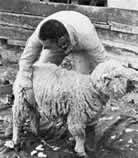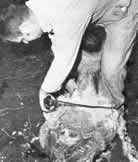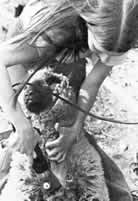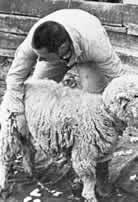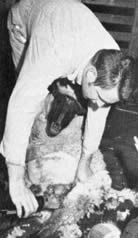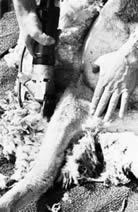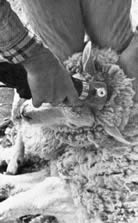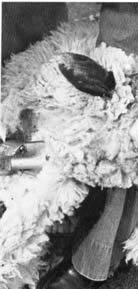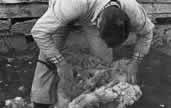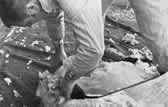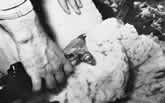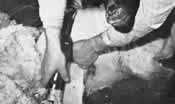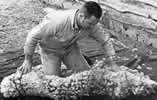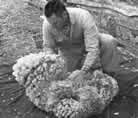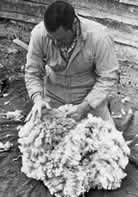by Suzanne Carr
Drawings by Alexa Hoke
Photographs by Stephen Hough
(Bittersweet, Volume II, No. 4, Summer 1975)
- ---
Though never very plentiful in the Ozarks, the small flocks of crossbred sheep have persisted from earliest times to the present. The gentle animal which eats objectionable brush, provides meat and cash from the lamb crop, also has another product more important than all the rest--its wool.

Years ago and today the breeding and care was for the finest, heaviest and longest fibered wool. Once the sheep provided the family with much of its textile needs which were prepared at home; today the wool goes to woolen mills where it is manufactured for public consumption.
But not all of it even today goes industrial route Some girls and women are rediscovering the once necessary pioneer craft and are experiencing the great satisfaction of creating a useful, beautiful and warm garment straight from the backs of the animals themselves. Some of us at Bittersweet, under the instruction of Carol and Carl Lee began to learn the long process by shearing sheep.
Sheep should be sheared at least once a year, although some people do it twice. The best time is spring or early summer when the sheep are having their lambs. Some shear before lambing. Since a new-born lamb does not have much wool to protect it from the cold, it chills easily. Shearing the mother at this time prevents her from ranging out into the cold weather away from shelter. Her staying where it is warmer prevents the lamb from following her out and freezing.
The sheep are easier to shear when the weather is bright and sunny. Sheep wool has a lot of lanolin in it. The sun's warmth brings out this lanolin, making the fleece much easier to cut.
Yearlings have better fleeces than ones sheared every year. Their coat grows faster and since they are born in February and March of the preceding year, their fleece is longer.
It is difficult to learn to shear a sheep, for it takes skill and is very hard work until you learn how to do it. The reason there are not more shearers is the fact that it is very hard to learn to be good enough to make any money. A beginner can shear only eight to ten sheep in a day and since the pay is usually one dollar a head, that would just not be profitable. Shearing seventy to a hundred a day becomes economically feasible.
You need to learn to shear without manhandling the sheep. You have to be fairly strong, especially in the legs. But being a small person is not a disadvantage while shearing, for being small will keep you from bending over so much. Taller sheep are harder to shear because you can not hold them as well.
A sheep is a permissive animal and as long as you are in complete control, they usually won't fight, but if they think they can get away, they will start kicking and struggling, making shearing difficult. A shearer ought to be able to hold a sheep with his legs without ever using his hands. The whole thing is to hold them with the feet and legs, leaving the hands free to operate the clippers. At any time you should be able to let go with the hands, but still have the sheep in control. If you have to use your hands, you are not holding it correctly with your legs. As long as the sheep is in a comfortable position, it gives up easily and stays quiet. Keep its forefeet off the ground so it will not struggle to get to its feet.
One of the main breeds that is found in the Ozarks is the Suffolk. It has a light and airy fleece which is easy to spin. Another type is Corriedale. Its fleece has long silky fibers and weighs eight to twelve pounds. The Montadale is also becoming a common breed in the area. It has a white fluffy fleece, usually six to eight pounds, which is excellent for dyeing and spinning. A lesser breed that is found is Hampshire. Its average fleece weight is eight to ten pounds. The wool is very white with a few black fibers in it which makes nice woolen yarn.
The price for a fleece varies widely. The price usually goes down in the winter, up high in spring, then it falls off again in summer. Different types and lengths of wool bring different prices. The long wool with fibers over two and a half inches brings about five cents more per pound. There is also a difference money-wise between a black and white fleece. A hand spinner will pay much more for a black fleece for the added variety or to mix with white wool. The commercial people pay less. Wool is sold by the pound, and anything over six pounds is considered a good fleece.
It does not take many tools to shear a sheep--a good pair of clippers and oil, a rug or protection from the ground, twine to tie the fleece and a sack to keep the wool.
The major tool used in shearing sheep is the clippers. Shearers now use electric clippers designed for sheep. The blade must be kept sharp because a dull one tends to pull the wool and it pulls the skin. Before electricity, shearers used hand clippers which needed strong hands and took more time.
A pair of old fashioned hand clippers
It is very important to have the clippers adjusted properly for efficient, even cutting. The clippers should be oiled between each sheep. Use a good quality machine oil to keep them operating best. Clippers not cared for properly or badly adjusted will cut poorly and will pull the wool, cutting the sheep. Sheep have very tender skin. Even with care and properly adjusted clippers one sometimes cuts the skin. The cut is like a razor cut. It bleeds a little but does not hurt--like a cut when shaving.
An old rug or other protection about six feet square is helpful to shear the sheep on. This is to keep the fleece clean.
Use a piece of paper twine about two to three yards long to tie up the fleece. You would not want to use anything like binder twine that has fibers in it because the fibers will get entangled in the wool.
A large 3 x 8 burlap sack is needed to put the finished fleeces in. This sack is usually hung from rafters in the barn or shed.
STEP BY STEP SHEARING
The shearing procedure outlined below is easiest on the shearer and the sheep. It utilizes the shearer's body and legs so that the hands can move the clippers quickly and efficiently over the animal. It also involves a minimum of changing the sheep's position. The shearing begins at the brisket and goes logically down the belly to the lower regions and legs to open up the fleece, and then proceeds systematically onto the lower left side. The shearer then starts at the head area, goes down and around the left side, and then, from the head area again goes down the right side ending with the tail. This removes the coat in one piece.
The way to handle sheep is to hold them right under their chins. Held in this position they will stay there for quite some time, but if you move your hand they'll try to get away.
Brisket -- To begin the shearing process, you must first get the sheep in a sitting position. To do this, place your left hand under its chin and your right hand around and underneath its body near the back right leg. Then force it into a sitting position. Hold the sheep tightly between your knees, and take four or five strokes with the clippers down the brisket.
Belly -- Next, shear the belly portion of the sheep. The belly is the hardest part to shear. Be very careful, for if the skin bunches up you'll start cutting the sheep.
Holding the sheep in the same position, pull out the right front leg to stretch the skin. Make two strokes down along the right side of the belly.
To shear the upper part of the belly, tuck the right front leg between the animal's body and your right knee, tightening the skin with your left hand. Take about four strokes across this part.
In order to shear the lower part of the belly, keep your left heel pressed against the sheep's back and take three strokes across.
Having tools within reach and rug protection underneath, Carl Lee shows that holding sheep in this manner gives complete control
When forcing the sheep into a sitting position to begin the shearing process. Sheep are gentle animals and will remain quiet while being sheared.
The first step in opening up the wool is making four or five strokes down the brisket. Suzanne holds the sheep in an upright position.
Supporting the sheep with his legs and stretching the skin along the belly, Carl makes three strokes along the lower belly.
Use the fingers of the left hand to tighten the skin, when you remove the wool from the udder of the ewe or the cod of a wether. You will need to make two short strokes down. Take three more strokes down to remove the wool from the back side of the cod or udder.
CROTCH AREA
Right hind leg -- Remove the tags from the front side of the right hind leg while placing your left hand in the stifle joint to keep the leg rigid and the skin taut. This should take one stroke downward. Then roll the sheep over a little to the right and use your left elbow to help hold it. Start at the end of the leg, and go upward, then repeat again. You should take extra caution to keep the sheep from kicking when shearing down near the end of the leg.
Crotch -- Place the fingers of the left hand over cod or udder to stretch the skin to shear the crotch and inside part of the left leg. This,should take three downward strokes.
With sheep still in upright position, very carefully stretch out the skin on udder area and shear crotch and inside of left leg.
Left hind leg -- Roll the sheep to its right hip. Put pressure on the stifle joint and remove the tags from the front side of the left hind leg and wool from the inside of the leg. Three downward strokes are needed for this.
LEFT LOWER REGION
Flank - To remove wool from the left flank, roll sheep on its right hip and use your left hand to stretch the skin. Start the first stroke just below the stifle joint. This will take two upward strokes.
Leg and hip -- Place your left hand and apply pressure to the stifle joint to remove the wool from the sheep's left leg and hip. This should take seven strokes downward.
To remove wool on the outside of legs put pressure on the stifle joint to keep sheep from kicking. Procedure for each leg is the same.
HEAD AND NECK AREA
Top knot -- The next step is to shear the sheep's top knot which will take three upward strokes. Hold the sheep's neck with your left hand but otherwise use the same positions as before.
Neck -- Place sheep between your legs. With your left hand, pull the head around and take one stroke upward from the brisket to the right jaw.
Keep rotating the sheep's head and place the nose up and the right side against the leg. Take two strokes upward to remove the wool from the throat to the jaw. The last stroke should remove the wool to the base of the left ear.
Shear the top knot.
One stroke from brisket to jaw.
Ear -- With the sheep's head against your leg, hold the ear and shear up around it.
Eye -- Bend the sheep's head on back, but still hold the sheep's ear. Shear one stroke up over its left eye.
Head -- Remove the wool from top of head and back of neck but do not change the position of the sheep. Two downward strokes are needed.
LEFT SIDE
Shoulder -- Put the sheep's body between your knees while holding the head against the left leg with your elbow. Take your left hand and stretch skin on the sheep's shoulder. Four upward strokes are needed for this step.
Shear shoulder with four strokes.
Side -- Place the sheep on its back. Put the right foot between the sheep's hind legs and the left foot placed under the right shoulder. Stretch the skin on the side by forcing the sheep's left foreleg toward the sheep's head. Make two strokes upward along side.
Make another upward stroke further down the side toward the backbone. Roll sheep against your left leg and apply pressure to its foreleg.
Put your right knee on sheep's left hip with your left leg underneath the sheep's shoulders. Make three upward strokes and the last one should get along the right side of the backbone.
RIGHT SIDE
Jaw -- Place the sheep's head in toward its body and take two downward strokes to shear right jaw.
Neck -- Holding the sheep in the same position place your left hand around its neck. Take two downward strokes and shear right side of its neck.
Shoulder -- While still keeping the same position, roll the sheep upright and make two downward strokes over sheep's shoulder.
Foreleg -- Put the sheep's right foreleg in front of your leg and place your left hand on the sheep's shoulder blade.
Shear the back side of the right foreleg, being sure to keep the skin tight. This should take two downward strokes.
Side -- Tuck the sheep's right foreleg back between your legs and keep its head down on its left side. After completing four downward strokes, move your left leg to other side of sheep's hind legs and raise the head to make another stroke.
(Above)With long steady stokes, shear along the right side of the sheep. (Below)until reaching the hip where you make shorter strokes down to the leg.
Hip -- Lay sheep over practically on its left side. Place your hand on the stifle joint to keep the sheep from kicking. Hold the sheep's head between left arm and right leg, and move the right foot around toward the sheep's hip taking four strokes across.
Finishing off the right hind leg.
TAIL
Completely lay the sheep on its left side and shear downward over tail. Keep the sheep's head between left arm and right leg. Again use your left foot under the sheep's shoulders.
TYING THE WOOL
Spread the fleece, which is in one piece, out on the rug skin side out. Then fold in from each of the long sides to the middle. Then fold over each end also to the middle. Tie with the paper twine securing it with a bow knot.
Spread the fleece skin side out on the rug. Fold to the center each of the long sides.
Fold the head and tail portions to the middle, giving a bundle affect.
Tie the fleece securely, with paper twine as you would a package.
SACKING THE WOOL
Immediately drop the tied fleece into the burlap sack. When the sack is half full (15 fleeces or so), someone must get inside the sack to mash the wool down. Continue filling until full.
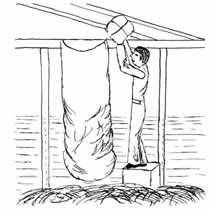
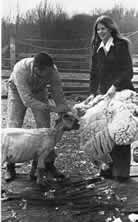
Carl congratulates Suzanne after shearing her first sheep.




